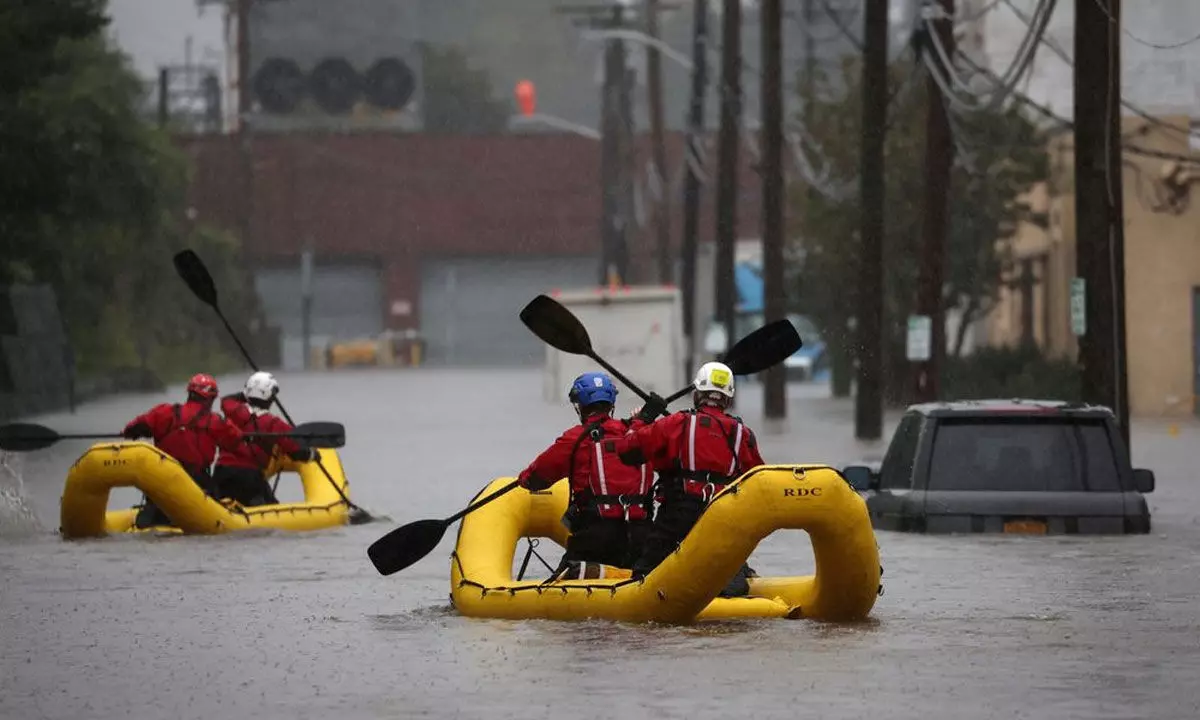Live
- They always want me to win, and now I feel lucky to have been offered a story like ‘Zebra’: Satyadev Kancharana
- ‘Democracy first, humanity first’: PM Modi in Guyana's parliament on two countries' similarities
- PKL Season 11: Telugu Titans register third straight win to top standings
- Is Pollution Contributing to Your COPD?
- NASA Unveils Underwater Robots for Exploring Jupiter's Moons
- Additional Central forces arrive in violence-hit Manipur
- AR Rahman and Saira Banu’s Divorce: Legal Insights into Common Issues in Bollywood Marriages
- 82.7 pc work completed in HPCL Rajasthan Refinery area: official
- Curfew relaxation extended in 5 Manipur districts on Friday
- Tab scam prompts Bengal govt to adopt caution over fund disbursement
Just In
Climate-driven flooding threatens millions in US


As Americans endure extreme heat and wildfires exacerbated by fossil fuel-driven climate change, an analysis revealed Tuesday that rising seas threaten infrastructure critical for millions of people in hundreds of U.S. communities.
As Americans endure extreme heat and wildfires exacerbated by fossil fuel-driven climate change, an analysis revealed Tuesday that rising seas threaten infrastructure critical for millions of people in hundreds of U.S. communities.
The Union of Concerned Scientists (UCS) report notes that "the nearly 90 million people living in U.S. coastal communities depend on an array of critical infrastructure," which the group defined as "assets and facilities that provide functions necessary to sustain daily life," including "schools, hospitals, public and affordable housing, energy infrastructure, and wastewater treatment plants."
"We also include known sites of industrial contamination that, if they were to flood, could expose people to toxic or hazardous pollutants," UCS explained. "The resulting list of critical infrastructure analyzed here is in some instances more expansive than the types included in the U.S. government's definition but does not include all the types that are
likely of concern to individual communities."
Kristina Dahl, the report's lead author and a principal climate scientist at UCS, pointed out in a statement that "if these facilities are flooded even just once, it can be incredibly disruptive or even paralyzing to daily life."
"Communities don't have long to prepare before their vital coastal assets are routinely under threat from climate change-caused flooding," she said. "Our analysis shows that by 2030, the amount of critical infrastructure at risk of repeat flooding along U.S. coastlines is expected to grow by 20% compared to 2020 conditions."
The group analyzed three scenarios for the rest of this century—seas rising by 1.6 feet, 3.2 feet, and 6.5 feet—and also found that "between now and 2050, climate change-driven sea-level rise will expose more than 1,600 critical infrastructure assets coastwide to disruptive flooding at least twice per year."
That's "a near doubling from 2020 exposure and a 53% increase relative to 2030 exposure," the report states. "Of those assets, nearly 1,100 are expected to flood monthly, on average, in this time frame."
The states facing the highest threats of disruptive flooding are Louisiana, New Jersey, Florida, Maryland, and California. Already, some insurance companies are bailing on coastal communities due to the rising disaster risk. The new publication says that "future flooding particularly threatens public and affordable housing."
Erika Spanger, a report co-author and director of strategic climate analytics at UCS, noted that "even if their homes stay dry, disruptive flooding of vital infrastructure could leave people essentially stranded within their communities or enduring intolerable and even unlivable conditions."
The document highlights that "this burden is borne inequitably: More than half the infrastructure at risk by 2050 is in communities at a disadvantage based on historical and ongoing racism, discrimination, and pollution."
"The amount of infrastructure in jeopardy late this century will depend heavily on countries' choices about global heat-trapping emissions," the publication stresses. "Policymakers and public and private decision-makers must take immediate, science-based steps to safeguard critical infrastructure and achieve true, long-term coastal resilience."
The report includes sections for six specific recommendations: Use science and innovation to plan for near- and long-term risks; Scale up public and private sector funding for infrastructure resilience; Reduce historical inequities and prevent future harms; Protect affordable housing; open just pathways to retreat; Start informed, flexible, adaptive planning now for later-century potential outcomes; and Cut heat-trapping emissions to limit the pace and magnitude of sea-level rise.
"There is a narrow window of time for federal, state, and local policymakers to provide funding and resources and for local decision-makers to use this backing to implement changes in their communities in preparation for an inevitable increase of regular disruptive flooding," the document warns. "Investments in resilience, equitably shared, can help build a safer, fairer future for all."
(https://www.commondreams.org/)

© 2024 Hyderabad Media House Limited/The Hans India. All rights reserved. Powered by hocalwire.com






